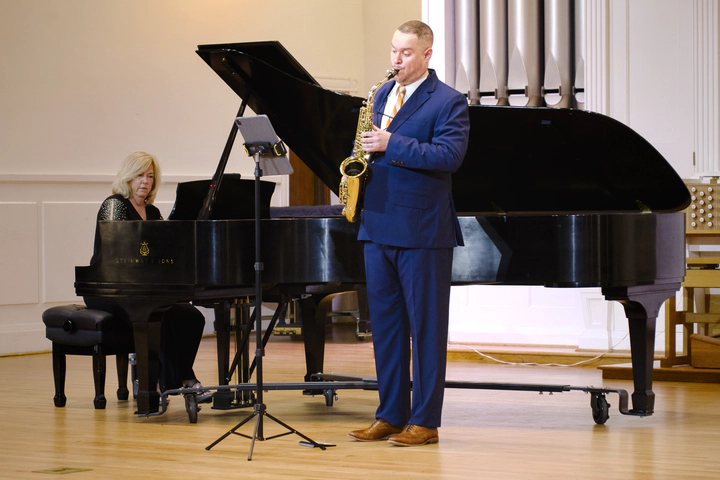Mid-century Modern: Works for saxophone from the American mid-century

Faculty Recital
Dr. Timothy Rosenberg, saxophones
Susan Eissele, piano
Program
Sonata for alto saxophone and piano, Op. 19 (1939) by Paul Creston (1906-1985) I. With vigor II. With tranquility III. With gaiety
Sonata for saxophone and piano (1937) by Bernhard Heiden (1910-2000) I. Allegro II. Vivace III. Adagio — Presto
Diaphonic Suite (1954) by Ruth Crawford (1901-1953), arr. Timothy Rosenberg I. Scherzando (attacca) II. Andante (attacca) III. Allegro (attacca) IV. Moderato ritmico
Three Pieces for saxophone and piano (1967) by Dorothy Rudd More (1940-2022), arr. Timothy Rosenberg I. Vignette II. Episode III. Caprice
Élégie et Rondeau (1961) by Karel Husa (1921-2016) I. Élégie (attacca) II. Rondeau
Program Notes
Mid-Century Modern: Works for saxophone from the American mid-century
A Journey Through Innovation and Expression
Emerging in the early 20th century, Modernism swept across numerous artistic disciplines, marking a profound response to the rapid technological and social changes of the era. From the awe-inspiring advancements like airplanes and space flight to the unsettling realities of atomic energy, these transformations deeply impacted humanity’s understanding of the world.
Modernist artists, initially ignited by these innovations, later grappled with their complex implications. This led to a collective desire to break free from traditional forms and established norms, paving the way for a spirit of experimentation and exploration. Composers embraced a diverse range of techniques, including Impressionism, Expressionism, and serialism, challenging conventional notions of harmony and melody. Atonality, with its rejection of a central key, and dissonance, with its clashing yet evocative chords, became new tools for expression.
This artistic movement found fertile ground in the United States, attracting European luminaries like Schoenberg and Stravinsky who immigrated and left their lasting mark. While deeply influenced by these giants, American composers like Crawford and Moore forged their own paths, drawn to serialism and Stravinsky’s stylistic elements respectively. This spirit of individuality became a hallmark of American Modernism, where artists embraced diverse approaches while sharing common themes:
- Rejection of tradition: A desire to break free from established norms and forms, paving the way for experimentation and innovation.
- Individuality and self-expression: Emphasis on personal voice and unique styles, reflecting the multifaceted nature of modern life.
- Understanding the human condition: Seeking new ways to represent the lived experience of individuals in the midst of rapid change.
Through this groundbreaking movement, artists across disciplines, including the composers featured in today’s program, challenged conventions and embraced innovation, leaving an enduring legacy that continues to resonate today.
Beyond Tradition: Embracing Individuality
Despite their distinct styles, these composers share a common thread: a rejection of tradition. Their compositions break free from established forms and explore innovative approaches to harmony and rhythm.
Paul Creston’s Sonata for Alto Saxophone and Piano: A cornerstone of the repertoire, this sonata exemplifies his innovative spirit. Harmonies move through many keys with liberal uses of chromaticism, influenced by both jazz and European modernism. Listen for unexpected shifts in mood and rhythmic complexity, reflecting the dynamism of modern life and the lyricism of American musical traditions.
Bernhard Heiden’s Sonata for Saxophone and Piano: Rooted in a neoclassical framework, this sonata utilizes dissonance and fresh interpretations of traditional form. Listen for the opening chromatic theme in the saxophone, hinting at the emotional depth explored throughout the piece. The “Scherzo” movement explodes with playful energy, while the final “Presto” showcases virtuosic writing for both instruments.
Ruth Crawford’s Diaphonic Suite: Originally written for flute or oboe, this intricate work showcases Crawford’s fully-developed serialist technique. Unlike other serial works, the underlying tone row only contains seven pitches instead of using all twelve. Even when breaking away from using traditional scales to form melodies and turning to serial techniques, Crawford was not . The third movement (Allegro) contains numerous permutations of Crawford’s row in a constant stream of fast-moving notes.
Dorothy Rudd Moore’s Three Pieces for Saxophone and Piano: Originally for violin, these pieces showcase Moore’s distinct voice. Polychords, angular melodies, and unpredictable rhythms create a sonic landscape that is both challenging and deeply personal.
Karel Husa’s Élégie et Rondeau: Husa’s Élégie opens with a somber and vaguely folk-like saxophone melody, soon joined by the piano in a dialogue of introspective reflection. The Rondeau bursts with playful energy, featuring rhythmic complexities and virtuosic passages that showcase the dynamic range of both instruments.
Exploring the Human Condition: A Profound Reflection
Beyond technical innovation, these composers delve into the complexities of the human condition. Creston and Heiden’s sonatas reflect the enthusiasm for innovation and anticipation for things to come. Crawford Seeger’s Diaphonic Suite, despite its intricate structures, possesses a meditative quality, inviting the listener to contemplate their meaning. Rudd Moore’s Three Pieces, while challenging with their technical demands, also hint at themes of resilience and personal expression in the face of societal constraints. Husa’s Élégie et Rondeau, with its somber melodies and moments of intense dissonance, evokes a sense of introspection and emotional turmoil.
A Tapestry of Sound: Experiencing Mid-Century Modernism
This program invites you to immerse yourselves in the vibrant tapestry of mid-century American saxophone music. Each piece represents a unique voice, reflecting the individual style of the composer while embodying the broader artistic currents of the Modernist era. As you listen, allow yourself to be captivated by the compositional virtuosity, the innovative soundscapes, and the profound reflections on the human condition woven into these compositions. Discover how the American spirit, fueled by both tradition and innovation, found its voice through these works for the saxophone.